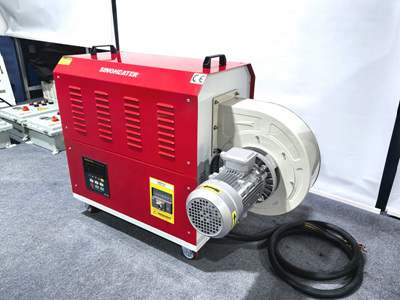Before painting on the metal surface, using a hot air blower for preheating operation is a key step to enhance the adhesion of the coating and improve the coating quality. The following are the detailed operation guidelines, technical points and precautions:
First, the core purpose of preheating
Dehumidification and rust prevention
If there is moisture or condensation dew on the metal surface, it will cause the coating to bubble and peel off. Preheating can quickly evaporate moisture and reduce the risk of rust.
Case: In a humid environment, rust spots appeared on unpreheated metal surfaces within 24 hours after painting, while metal surfaces preheated to 40℃ showed no rust after 30 days of painting.
Improve adhesion
Preheating enhances the molecular activity of the metal surface, forming stronger chemical bonds with the resin in the coating.
Data: For the metal surface preheated to 60℃, the adhesion of the coating (ASTM D3359 standard) can reach 5B (the highest grade), while for the unpreheated surface, it is only 3B.
Improve the leveling property of the coating
High temperature reduces the viscosity of the coating, enhances its fluidity, and decreases surface defects such as orange peel and pinholes.
Effect: After preheating, the uniformity of the coating thickness is improved by 30%, and the gloss is increased by 15%-20%.
Second, the operation steps for preheating the hot air blower
1. Equipment and parameter selection
Type of hot air blower
Industrial-grade hot air blower: Suitable for large areas of metal (such as steel structures, pipes), temperature range 50℃-300℃, air volume ≥500m³/h.
Portable hot air gun: Suitable for local repair or small workpieces, with adjustable temperature up to 600℃ and nozzle diameter ranging from 3 to 8mm.
Key parameters
Temperature setting: Adjust according to the type of metal and coating requirements (see the table below).
Wind speed control: Maintain a medium speed (2-3 gears) to avoid the paint being blown away by high-speed air flow.
Heating distance: The nozzle is 15-30cm away from the metal surface to ensure uniform heat distribution.
2. Operating Procedures
Surface cleaning
Sand off the oxide layer with sandpaper (80-120 mesh), and then blow off the dust with compressed air.
Do not use oily cleaners to avoid residues affecting the coating.
Preheating implementation
Uniform heating: Move the hot air blower along a “Z” -shaped trajectory to avoid local overheating.
Temperature monitoring: Use an infrared thermometer for real-time detection to ensure that the surface temperature reaches the set value.
Time control: Adjust according to the thickness of the metal (see the table below).
The timing of painting
After preheating, the painting should be completed within 5 minutes to avoid a decrease in adhesion due to a drop in temperature.
When painting, the surface temperature of the metal should be at least 5℃ higher than the ambient dew point temperature.
Third, key points to note
Avoid overheating
When the temperature of the metal surface exceeds the temperature resistance limit of the coating (such as water-based paint ≤60℃), it will cause the coating to wrinkle and crack.
Risk case: A certain factory preheated galvanized steel to 80℃ and applied water-based paint. As a result, the coating cracked within one hour.
Prevent oxidation
If the paint cannot be applied immediately after preheating, it should be protected with inert gas (such as nitrogen) or covered with an anti-oxidation film.
Safe operation
Protective equipment: Operators need to wear heat-insulating gloves, goggles and dust masks.
Fire prevention measures: Flammable materials are prohibited from being stored within 1 meter around the hot air blower. Fire extinguishers should be provided.
Power-off inspection: After operation, turn off the power and wait for the hot air blower to cool down before storing it.
Fourth, methods for effect verification
Adhesion test
The grid drawing method: Use a blade to draw 1mm×1mm grids on the coating surface. After attaching the tape, quickly peel it off. If the area that falls off is ≤5%, it is qualified.
Pull-out method: Use an adhesion tester to measure the peel strength between the coating and the metal (≥5MPa is qualified).
Weather resistance assessment
The simulated salt spray test (5% NaCl solution, 35℃, 48 hours) shows that the coating is qualified if there is no rust or bubbling.
Fifth, Summary
Preheating with a hot air blower is a crucial step before metal painting. The temperature and time need to be precisely controlled based on the type of metal, the characteristics of the coating, and environmental conditions. Through standardized operation, the quality of the coating can be significantly improved and its service life can be prolonged. For high-value or complex-structured metal parts, it is recommended to conduct full-process monitoring in combination with professional testing equipment (such as coating thickness gauges and infrared thermal imagers) to ensure that the coating effect meets the standards.




